Everything You Need to Know About Playing Thresh
Thresh has been a staple support for professionals and solo queue play for years. This article will give you all the information you need to know to play Thresh effectively!
Thresh has been a staple support for professionals and solo queue play for years. This article will give you all the information you need to know to play Thresh effectively!
Thresh continues to be a powerful pick for amateurs and professionals alike. His versatility and powerful kit make him a great pick in many scenarios, and he is a pocket pick that most support mains should be able to pull out. He can adapt his playstyle to play more offensively or defensively depending on the matchup. Overall, he is a great champion to know how to play well, and with the planned buffs to him, now is as good a time as any to learn how to play him!
Thresh is a champion with a high skill ceiling but also a high skill floor. That is, you can perform reasonably well on him even if he is not your main champion. However, by learning some interactions and fundamentals, you can bring your Thresh support to the next level
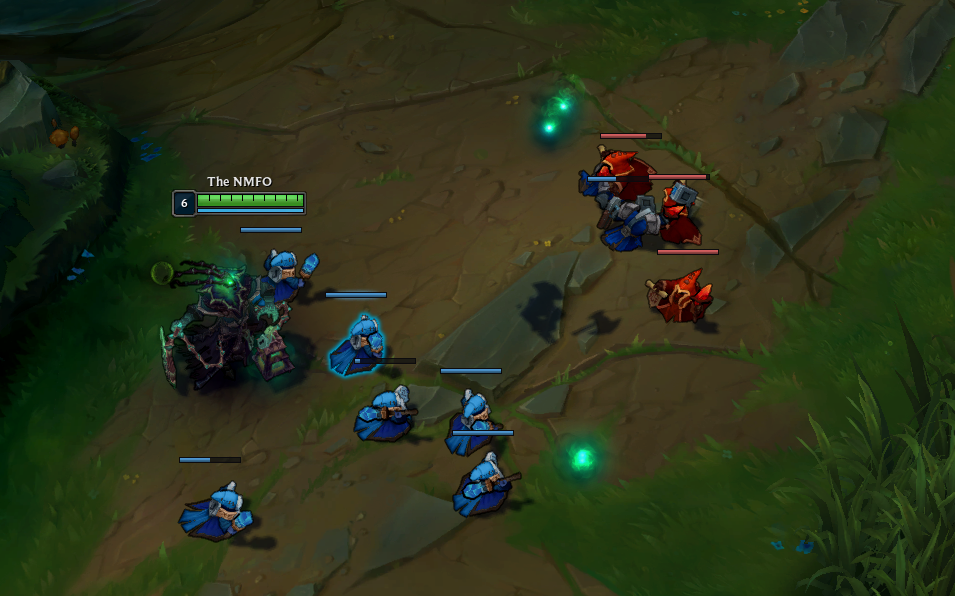
This passive means that when champions, siege minions (cannons), or large monsters die near you, they drop one soul. Baron Nashor and Dragons drop two souls, and small minions and monsters have a one in three chance to drop a soul. For every soul collected, Thresh gains one armor and one ability power. The trade-off for this is Thresh cannot increase his base armor by leveling up, like every other champion. Thus, collecting these souls is necessary not only for the free stats, but also to make sure his armor is keeping up with the base armor of every other champion. If you are prudent in collecting souls, you can actually exceed most other champions’ armor, but if you fall behind, you’ll be noticeably squishier than other champions.
Additionally, two of Thresh’s other abilities also scale off the number of souls that Thresh collects. The shield on W – Dark Passage and the minimum and maximum bonus damage on E – Flay also scale off the number of souls Thresh collects. So, it is not only important for you to collect these souls for your stats; you’re helping out your team by doing so too!

Probably one of the most iconic moves in League of Legends. Death Sentence throws out your scythe, stunning the first enemy hit, tugging them slightly towards Thresh, then allowing Thresh to fly towards the enemy’s location. This is the major ability that defines a player as a good Thresh player or a bad one. The ability to land hooks consistently is game-changing. Setting up hooks and combos you can do off them will be discussed more in detail in a later section.
Note that Thresh’s scythe is counted as a projectile and, therefore, will be mitigated by Yasuo’s Windwall as well as Samira’s W. Additionally, if the enemy has a form of crowd-control immunity, such as Malzahar’s passive, your hook will not stun them. However, you will still be able to recast the ability. This makes it extremely useful as a counter to spell shields, as you can still follow up by recasting Q and using your Flay to catch them.

Colloquially known as “Lantern,” this is hands down one of the most powerful abilities in the game. Underused and underappreciated outside of the pro scene, this ability essentially acts as a get out of jail free card for one of your teammates, which makes it invaluable. In addition, you can bring in teammates from very far away to follow up on your engages, making your effective range much larger. When you press W, you throw out your lantern to a target location, granting a shield to the nearest ally. It also picks up any nearby souls and gives them to Thresh. When an ally (but not an enemy) clicks on the lantern, they are carried to Thresh’s location.
The power of this ability is hard to overstate. This ability alone makes Thresh one of the best champions to peel for teammates. Thresh can be over a wall, completely separated from a teammate, yet throw his lantern to a teammate and save them from a completely lost position. This ability enables many immobile Attack Damage Carries (ADCs) that would be otherwise unviable to be playable. The lantern essentially acts as a free dash to ally champions, which can be immensely powerful against champions like Jarvan IV. This is why you see pro players will usually pick champions like Aphelios if they are paired with Thresh, because Thresh offers so much safety.
However, this ability also offers immense offensive power. If another hook champion, such as Nautilus, hooks you, but his team isn’t around, then it doesn’t really matter. You can likely just walk away before his team gets there, or you could just kill him. However, with Thresh, it does not matter if his team isn’t right there to follow up; he can simply throw a lantern to his teammate off-screen and bring an ally directly to him. It is this versatility that makes Thresh’s lantern such a powerful ability. Don’t sleep on the shield either! Late game, the shield can be upward of 200 health, which can make a difference!
Fun fact! This ability is considered a unit in the code, and therefore it can theoretically be teleported to!
A niche mechanic to know with Thresh’s lantern is that the ally who clicks on it will continue to follow Thresh until the first time that the ally arrives with Thresh. Practically speaking, this means that you can extend the range of the lantern if you take a movement action after the ally clicks on the lantern. So, if you hook an enemy, throw out your lantern, the ally takes the lantern, and then you recast your Q ability, then your ally will be transported with you to the hooked target, even if that target was outside of the lantern’s range. Defensively, you can throw out a lantern to an ally, the ally clicks on the lantern, and then while in-flight, you can Flash over the wall and bring the ally over the wall with you for extra safety. Beware, though! Once an ally clicks on the lantern, it is a one-way trip. You might accidentally bring your ADC into the entire enemy team if you aren’t paying attention.
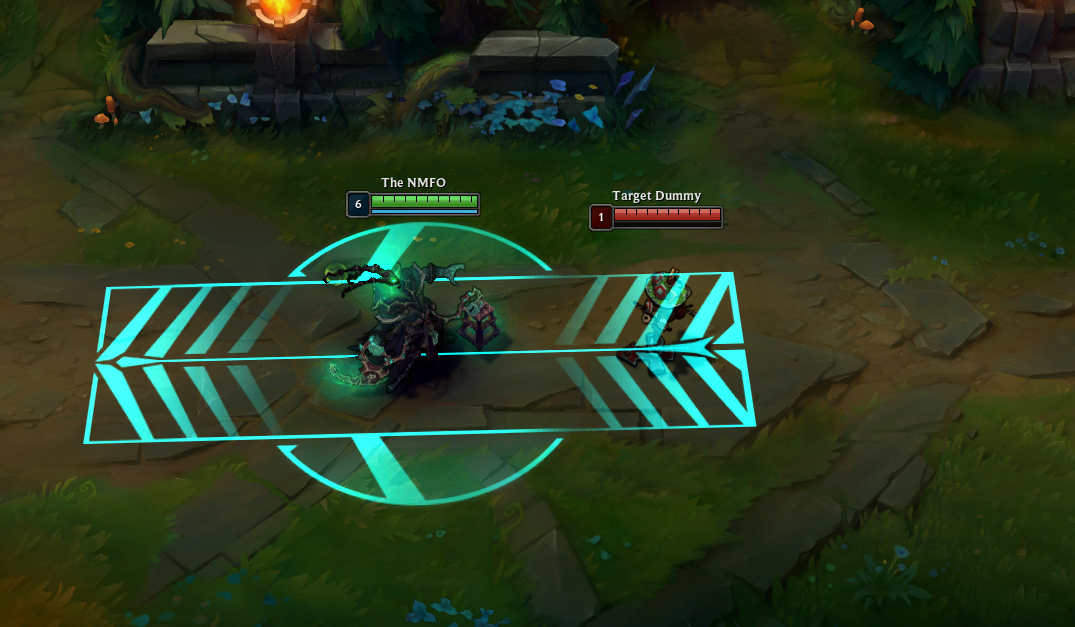
This ability is yet another powerful tool if you know how to use it. The passive gives you increasing bonus magic damage on attack depending on how long it has been since your last attack. This is mainly used for early game trading and poking out melee support champions in lane. It too scales with souls collected, so while you shouldn’t be just auto-attacking enemies, the damage isn’t completely negligible. You can use Flay to either pull enemies towards you or push them away from you, depending on the direction you cast the ability. Hitting an enemy with the ability also slows them, so it is helpful to use when chasing down opponents or for setting up hooks, detailed later. However, it also is an extremely useful defensive tool as well, for both disengaging and peeling. Because Flay will knock up enemies it hits, it interrupts channels or abilities that require the user to stand still. For example, if a Samira dashes into your team and uses her ultimate, because it is interruptible, you can Flay her out of it immediately and cancel most of the damage. This applies to other Ultimates that require channels such as Katarina’s or Miss Fortune’s as well.
If you time it correctly, it can also be used to interrupt most stoppable dashes in the game. Of course, dashes that are unstoppable such as Vex’s ultimate or Malphite’s ultimate will not be stopped by flay. However, many other dashes are realistically preventable. If an Alistar attempts to Headbutt and Pulverize you, you are able to interrupt it. If Leona tries to E onto your ADC, you can Flay her out of it. However, some dashes are much quicker and will require you to not just react to it, but predict it. It is possible to stop the damage from Akali’s ultimate recast, however because the dash speed is so quick, you will have to predict the timing of it, unless you have very good reaction speed and low ping. So while many players are interested in flashy Flay picks and offensive plays, never forget how useful Flay is as very quick hard crowd control!
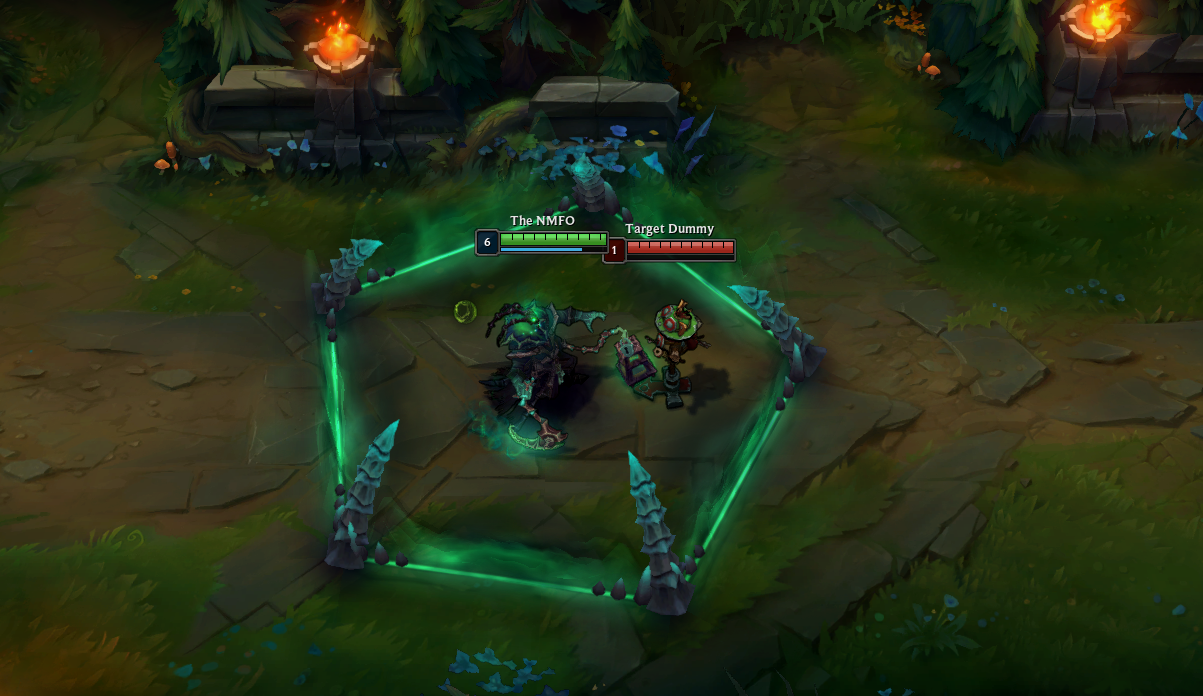
Somewhat ironically, Thresh’s ultimate ability is really his simplest ability. It is one of the few 99% slows in the game left. It is a pretty straightforward zone-denial tool. You can either use it after you hook someone to make it extremely hard for them to escape the Box, or you can use it if you are being chased to either keep the enemies from reaching you or at least slowing them down enough to let your ADC run away.
Unless you are invading, the traditional first skill for Thresh is one skill point in E – Flay. The reason why involves a little bit of theory. In most cases, with rare exceptions, there is not really a time when the hook will be more useful than Flay. When you level Flay, you will be able to come to lane with a fully charged enhanced auto-attack from Flay’s passive. Additionally, while Death Sentence can only crowd control one person, Flay can affect both enemies and activate runes like Font of Life. Overall, leveling Flay first will almost always result in better damage output and more useful Crowd control (CC) than Death Sentence. The obvious exception here is if you are invading as five people, and one long stun will result in a kill.
Typically, a Thresh support will max his skills in the order W – Q – E, and maxing ultimate as soon as he can. You want lantern to be available as often as possible for playmaking and the increased shield is strong early. Flay already has a fairly low cooldown relative to the rest of Thresh’s kit, and additional levels don’t give too much meaningful additional damage. Therefore, maxing Q next allows for more hook attempts and more pick potential.
Thresh is interesting as a support as there are cases to be made for taking Guardian, Aftershock, and Glacial Augment. In the current season, with the rework to Glacial Augment, it is the most favored rune for Thresh support. The additional slow and damage reduction makes it very strong in lane and pick potential. That being said, you sacrifice the extra survivability that Aftershock gives you, as well as the periodic shield from Guardian. You can find success with any of these runes; it becomes more comfort and matchup dependency. For the current patch, 12.9, Glacial Augment is considered to be the stock standard rune to take. However, in the abstract, for hard all-in team comps, you will want to go either Glacial, for early bully comps, you will want to go Guardian, and for comps where you need to get through tanky frontlines, you will want to go Aftershock. However, these are rules of thumb and feel free to adjust as needed. This is one example rune page:

Flash is an absolute essential. There is just too much value offensively, and defensively for Thresh to sacrifice it. He has no real dashes to justify not taking it. Most of the time, you will be taking Ignite to help secure more kills. The one exception is if you’re running a hyper-carry team composition into assassins, in which case taking Exhaust is acceptable. Most of the time, though, take Ignite as your second summoner spell. Thresh prefers to have mobility boots if at all possible; it opens up his roams and playmaking ability. However, if the enemy team is stacking auto attackers or mages, you can make the switch for either Plated Steelcaps (ninja tabis, for you older players), or Mercury Treads.
As of the current patch, 12.9, Thresh almost exclusively goes Locket of the Iron Solari. Locket just offers a team too much survivability to patch up, with the increased resistances as well as an on-command shield. However, if the meta shifts, do not sleep on Evenshroud. This item combos very well with Thresh’s many forms of CC, as well as his tendency to be CC’d himself. If you find yourself facing an extremely tanky composition, you can consider picking up Evenshroud as your mythic; otherwise, Locket is your more consistent bet.
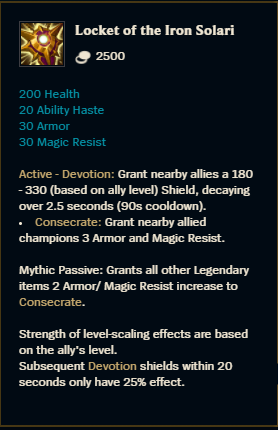
From here, Thresh’s items are very flexible and adaptable to the situation he is in. He does not really rely on any particular item to perform his role well, and you should take advantage of this. If the enemy team has a lot of healing, pick up Thornmail. If your ADC is going to be the target of assassins or divers, take a Knight’s Vow. Zeke’s Convergence is an overall good item for Thresh for the same reason Evenshroud is. Some pro players even go Redemption in their build, further beefing up his shields. Redemption combos really well with Guardian and Locket as well. Do not forget your Watchful Wardstone after level 13! This item is one of the most gold-efficient items in the game, and the value of the extra vision it gives you is priceless.
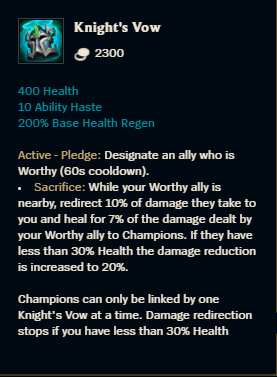
Landing your hook is the most visible expression of skill on Thresh, and your ability to land hooks consistently is a game-changer. You want to always throw hooks that have a good chance of either hitting or forcing a summoner spell out of your opponent. The most consistent way to do this is by setting up your hooks or comboing them off of ally abilities. Remember that your Flay has a slow build into it. If you are in range to do so, the most reliable way to hit a hook is to Flay the enemy towards you first, then throw your hook at them. This decreases the distance between you and the enemy and lowers their ability to dodge simply by walking away. However, this rule applies to nearly every slow or stun. For example, if Jhin can root an enemy with his W, so this is a perfect place for you to throw a hook and extend the CC. This is what is known as a CC chain, and your ability to know timings on these combos comes down to experience.
Remember that your hook has a rather long cast time. This means there is a delay between when you cast the ability and when the hitbox actually becomes active, especially at maximum range. You need to factor this time into both your predictions and your aim. People will either hear the sound cue or see the animation at higher ELO and begin trying to dodge. Throughout the game, make a note of hooks you miss and whether players tend to dodge up or down from the hook. Use this to adjust accordingly in your matches. Additionally, some champions have dashes you can predict. One example is Katarina. She will tend to want to dash to one of her daggers to reset her cooldowns, so if you think she will do that, throw your hook at her dagger and try and catch her out.
Remember, you do not need to face the direction you will throw your hook. As long as your character is looking roughly ninety degrees in the direction you are throwing the hook, you will not necessarily be looking in the same direction you throw the hook. If you always throw the hook straight forward, it becomes much easier to predict and react to. Vary up your hooks by looking in a different direction than you throw.
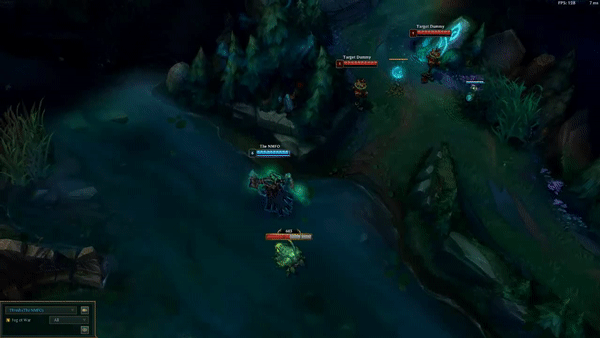
Once you hook an enemy, if it is a high-value target like an ADC, the most common follow-up is to recast Q, then Flay the enemy and activate your ultimate on them. Remember, you can throw your lantern before you recast Q to take an ally with you, so this might be helpful in pick scenarios. If you end up hitting a tank, the play might not be over. If an ADC or control mage is standing too close to the tank, you can consider taking the Q anyway, then flaying the mage and putting The Box around them as well, again potentially bringing a teammate to assassinate them with. Your Q does work on monsters, so if you are on the wrong side of a Baron or a Dragon wall, you can Q the monster, throw a lantern to your jungler, and try for a steal.
Early game Thresh depends a lot on the lane matchup. Your primary goal is to not get poked out of lane. You don’t win a lot of level 1 2v2s unless your opponent misplays or is playing a very passive lane, so do not hard force these plays. Your hardest counters are long-range poke champions like Zyra, Xerath, or Morgana. You have a very good level 2 power spike if you can hit it first. If you know you will hit level 2 first, start moving up past the wave as you hit level 2 and throw a hook out. If the hook is good, you can either force a summoner spell out or even get a kill. If it is bad, the enemy will likely still be level 1 and will not be able to punish you too hard. You mainly want to be warding, looking for missteps from enemy laners to pick them off, and keeping your laner safe with your W.
Mid game Thresh is looking to roam around the map with his ADC and look for picks. You should be keeping close enough to your ADC to throw a lantern for them if they need it, but you can be helping your jungler invade the jungle and set up deep vision. Remember to head for Dragon and Baron around a minute to forty-five seconds before they spawn. Look for laners that are overextended or isolated and pick them off. You’re looking to leverage your pick potential to score your team kills, towers, and objectives.
Late game Thresh is all about keeping your ADC safe. Once your ADC has scaled, it is no longer worth it to leave their side to force picks. Since your ADC has enough damage to wipe teams if they free hit, you need to be by their side to ensure the enemy divers and frontline cannot break through. Remember the tips about using Flay to stop dashes and using your lantern to reposition your ADC. You can still help look for picks and get vision, but after thirty minutes, if your ADC dies, it is hard to hold on to the game.
Now that you have the rundown on how to play Thresh, you can begin picking him in your matches and try these tips out for yourself! Remember your fundamentals when it comes to itemization, ability usage, playstyle, as well as general Support tips, and you can begin utilizing Thresh to his fullest capacity!